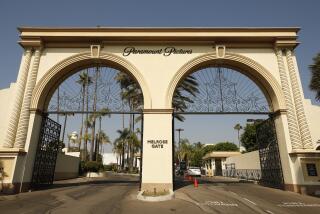Small radio’s big appeal
- Share via
Adam Nathanson is making the most of his media-rich bloodline.
His grandfather was an advertising man who published Radio Showmanship Magazine in 1940 and bought a radio station in 1952. His uncle Greg ran the Fox TV station group in the late ‘90s for Rupert Murdoch before retiring.
After his father, Marc, sold the family’s Los Angeles-based Falcon Cable TV company in 1999 to billionaire Paul Allen for $3.6 billion, Adam asked him to back his own entrepreneurial hunch. Nathanson wanted to buy radio stations even as new technologies were challenging the industry’s growth.
Today, six years after purchasing his first station, Nathanson, 36, is running California’s second-largest radio group after Clear Channel Communications Inc. Nathanson says each of the 34 stations owned by his Mapleton Communications has carved out a unique identity, allowing them to stand out in an industry criticized for a homogenized sound after years of consolidation and cost cutting.
Located mostly in small and mid-sized markets such as San Luis Obispo and Merced, Calif., his stations have in some instances seen revenue double or triple under Mapleton’s leadership, he said.
“I think radio is here to stay,” Nathanson said. “If you’re doing a good job, it stimulates the imagination.”
At a time when radio has fallen from favor on Wall Street, Mapleton has attracted new investors. In November, Lazard Alternative Investment’s Corporate Partners II fund bought a 39% stake in Mapleton for an undisclosed price. The investment will help fuel expansion of the company, which had $21.5 million in gross revenue in 2006 and 138 employees.
With hip glasses and a Mt. Everest climb under his belt, Nathanson seems part boyish adventurer, part family businessman. This winter, for example, he broke his ankle snowboarding in Aspen, Colo., but was hobbling around his office just days later proudly showing family pictures and a tattered copy of his grandfather’s magazine.
Nathanson says part of Mapleton’s success comes from the model his father used in building his cable TV company. Like Falcon, Westwood-based Mapleton targets mid-sized markets where the company can contribute to community development and make a name for itself.
Marc Nathanson is the chairman of both Mapleton and Mapleton Investments, which provided $9.7 million to purchase the company’s first cluster of stations in Medford, Ore., a former Falcon market.
In 2001, after helping launch MTV Latin America and managing a record label that included the Beastie Boys, Adam Nathanson approached his father over breakfast one morning at John O’Groats in Los Angeles about the idea of going into the radio business. He figured that with his father’s knowledge of small markets in California, his own brand and sales expertise, and a few experienced radio managers, he couldn’t go wrong.
It was a good time to get into small-town radio. The Telecommunications Act of 1996 allowed single companies to own more radio stations nationwide and in individual markets, spurring big companies such as Clear Channel to bulk up. By 2001, four companies controlled 90% of radio advertising revenue. The top radio group owned more than 1,000 stations nationwide, up from 39 stations in 1996.
Listeners complained that the consolidation had made radio bland as owners cut costs by relying on fewer disc jockeys and using uniform playlists that featured the same artists.
Nathanson realized that conglomerates probably would focus on big cities where they could generate the most revenue, allowing him to buy stations in smaller markets. If he invested the money and attention to make them superior to rivals owned by the majors, he could attract listeners and advertisers.
He was right about the value of nurturing smaller stations. In 2003, the regional vice president of Clear Channel in northern California oversaw 93 radio stations, devoting one-tenth of 1% of his time to any one of them, said radio broker Elliot Evers, managing director of Media Venture Partners.
“They do a pretty mediocre job in those small markets,” Evers said about the big corporations. “Whereas a company like Mapleton -- this is what they live for.”
Evers bought a station in Chico, Calif. -- one of Mapleton’s markets -- from Clear Channel in 2003, and the station’s profit has tripled since then. He’s seen other small and mid-sized stations thrive despite the increased popularity of Internet radio and iPods.
“You may not be able to succeed as rapidly as you could before the iPod age,” he said. “But a lot of people rely on radio.”
Nathanson has hired experienced radio managers to develop and market his stations as unique brands. One popular radio station, KPIG out of Santa Cruz, has a logo of a pig in overalls and has built its identity around that theme. Another, Radio Lobo in Merced, targets the Latino market. The company recently purchased stations in Redding, Calif., and in Chico, the site of the newest University of California campus.
Nathanson also introduced a program that rewards employees in markets that exceed their expected growth.
“You have a pretty aggressive company that believes in their people and is just trying to be the best radio broadcasters they can,” said Erica Farber, president and publisher of industry magazine Radio and Records.
Mapleton has helped fund a new amphitheater in Medford, Ore., sponsored events that bring artists to the smaller markets, and sells compilation CDs whose proceeds benefit local causes. On this, too, Nathanson took his cues from Falcon.
“You have to give back to the community, that’s really important,” Marc Nathanson said.
Jonathan Kagan, managing principal of Lazard’s new Corporate Partners fund, said that while the Internet might be taking advertising dollars from traditional media, “radio still offers the best value out of all the media that we’ve looked at.”
A small-market radio station is still the source for local news, high school sports, and as a result, local advertising, Kagan said. “We think that on a local basis radio has a very good future.”
*



